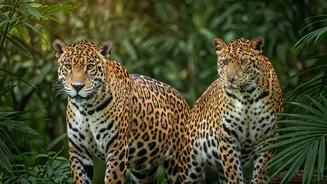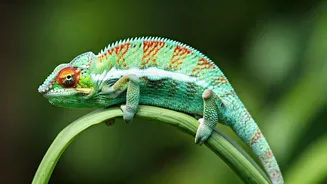Physical Appearance: Spots & Size
Jaguars and leopards, though both members of the Panthera genus, boast distinct physical traits. Jaguars are generally larger and more robust, with males
often weighing up to 200 pounds or more. They are characterized by a powerful build, essential for taking down large prey. Their coats sport distinctive spots, typically rosette-shaped with spots inside them, which help them camouflage effectively. Leopards, on the other hand, are smaller and more slender, with males weighing around 130-190 pounds. Their spots, also known as rosettes, are generally smaller and more densely packed, and lack the internal spots found in jaguar rosettes. This variation in size and spot patterns aids in their individual adaptation to diverse environments, offering distinct camouflage advantages in their respective habitats. These differences are key in spotting the difference.
Habitat and Distribution
The habitats and distribution of jaguars and leopards are vastly different, dictated by their environmental needs and survival strategies. Jaguars primarily inhabit the Americas, from the Southwestern United States through Central and South America. They thrive in dense rainforests, swamps, and even open savannas, areas offering ample opportunities for hunting. Their powerful build allows them to hunt a wide variety of prey in these challenging environments. Leopards, in contrast, are much more widespread, found across Africa and Asia. They are incredibly adaptable, inhabiting diverse terrains ranging from rainforests and savannas to mountainous regions and even deserts. This adaptability stems from their smaller size and hunting flexibility, enabling them to survive in areas where jaguars would struggle to find food and cover. The difference in their habitats reflects their ability to co-exist in different environments and successfully hunt their prey.
Hunting and Behavior Styles
The hunting styles and behaviors of jaguars and leopards showcase significant differences, shaping their respective roles within their ecosystems. Jaguars are powerful ambush predators, known for their strength and ability to take down large prey like capybaras, caimans, and even large livestock. They often stalk their prey and then use their powerful jaws to deliver a lethal bite to the skull. They also have a unique ability to swim, which they utilize when hunting. Leopards, in contrast, are more opportunistic hunters, adapting their strategies based on prey availability and habitat. They are known for their stealth and agility, and they often drag their kills into trees to protect them from scavengers. They eat smaller prey compared to jaguars, including monkeys, birds, and smaller ungulates. These differing hunting approaches reflect their adaptations to their distinct environments, highlighting the diversity and resilience of these magnificent predators.












